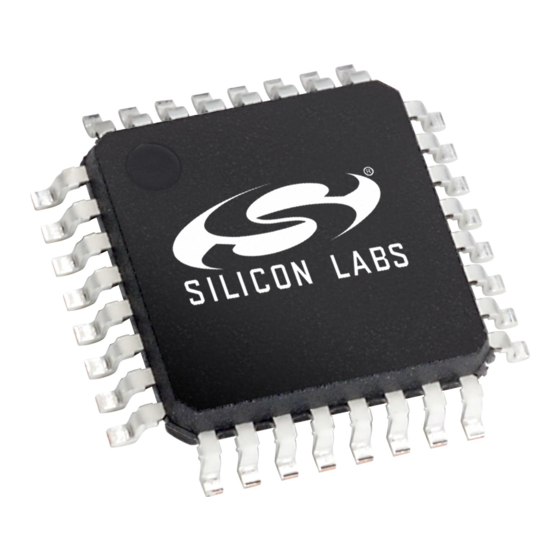
Table of Contents
Advertisement
Quick Links
C8051F35
D
X
1. Kit Contents
The C8051F35x Development Kit contains the following items:
•
C8051F350 Target Board
•
Serial Adapter (RS232 to Target Board Debug Interface Protocol Converter)
•
Silicon Laboratories IDE and Product Information CD-ROM. CD content includes:
•
Silicon Laboratories Integrated Development Environment (IDE)
•
Keil 8051 Development Tools (macro assembler, linker, evaluation 'C' compiler)
•
Installation Utility (SETUP.EXE)
•
Source code examples and register definition files
•
Documentation
•
AC to DC Power Adapter
•
RS232 Serial Cable
•
7" Ribbon Cable
•
Quick-start Guide
•
C8051F35x Development Kit User's Guide (this document)
2. Hardware Setup
The target board is connected to a PC running the Silicon Laboratories IDE via the Serial Adapter as shown in
Figure 1.
1. Connect one end of the RS232 serial cable to a Serial (COM) Port on the PC.
2. Connect the other end of the RS232 serial cable to the DB-9 connector on the Serial Adapter.
3. Connect the Serial Adapter to the DEBUG connector on the target board with the10-pin ribbon cable.
4. Connect the AC/DC power adapter to power jack P1 on the target board.
PC
Serial Port
Note: The Reset switch on the target board is disabled when the serial adapter is connected to the
target board. Use the Reset button in the Silicon Laboratories IDE toolbar to reset the target when
connected to the Serial Adapter.
Rev. 0.1 2/04
E V E L O P M E N T
Serial
Serial
Adapter
Cable
Figure 1. Hardware Setup
Copyright © 2004 by Silicon Laboratories
C 8 0 5 1 F 3 5 x - D K
K
U
'
G
I T
S E R
S
AC/DC
Adapter
Ribbon Cable
U I D E
Target Board
C8051F35x-DK
Advertisement
Table of Contents

Summary of Contents for Silicon Laboratories C8051F35x
- Page 1 C8051F35x Development Kit User’s Guide (this document) 2. Hardware Setup The target board is connected to a PC running the Silicon Laboratories IDE via the Serial Adapter as shown in Figure 1. 1. Connect one end of the RS232 serial cable to a Serial (COM) Port on the PC.
-
Page 2: Software Setup
ROM for additional information on using the Keil 8051 tools with the Silicon Laboratories IDE. To build an absolute object file using the Silicon Laboratories IDE project manager, you must first create a project. A project consists of a set of files, IDE configuration, debug views, and a target build configuration (list of files and tool configurations used as input to the assembler, compiler, and linker when building an output object file). - Page 3 Rebuild All button in the toolbar or select Project->Rebuild All from the menu. 2. C8051F35x family devices use the Silicon Labs 2-wire (C2) debug interface. You must select C2 in the Options->Debug Interface menu to enable connection to C8051F35x target devices. Click the Connect button in the toolbar or select Debug->Connect from the menu to connect to the device.
-
Page 4: Example Source Code
They are installed into the “SiLabs\MCU\Examples\C8051F35x” directory during IDE installation. The register and bit names are identical to those used in the C8051F35x data sheet. Both register definition files are also installed in the default search path used by the Keil Software 8051 tools. Therefore, when using the Keil 8051 tools included with the development kit (A51, C51), it is not necessary to copy a register definition file to each project’s file directory. -
Page 5: Target Board
C8051F35x-DK 6. Target Board The C8051F35x Development Kit includes a target board with a C8051F350 device pre-installed for evaluation and preliminary software development. Numerous input/output (I/O) connections are provided to facilitate prototyping using the target board. Refer to Figure 2 for the locations of the various I/O connectors. - Page 6 J9 and J10 and install the crystal at the pads marked Y1. Install a 10 MΩ resistor at R9 and install capacitors at C14 and C15 using values appropriate for the crystal you select. Refer to the C8051F35x data sheet for more infor- mation on the use of external oscillators.
- Page 7 C8051F35x-DK 6.3. Expansion I/O Connector (J1) The 34-pin Expansion I/O connector J1 provides access to all signal pins of the C8051F350 device. Pins for V GND as well as pins for VDDA and AGND are also available. A small through-hole prototyping area is also provided.
- Page 8 C8051F35x-DK 6.5. Serial Interface (J5) A RS232 transceiver circuit and DB-9 (J5) connector are provided on the target board to facilitate serial connec- tions to UART0 of the C8051F350. The TX, RX, RTS and CTS signals of UART0 may be connected to the DB-9 connector and transceiver by installing shorting blocks on jumpers J3.
-
Page 9: Serial Adapter
J13 and J14 should be left open. 7. Serial Adapter The Serial Adapter provides the interface between the PC’s RS232 serial port and the C8051F35x’s in-system debug/programming circuitry. The Serial Adapter connects to the C8051F350 C2 debug interface on the target board using the 10-pin connector on the Serial Adapter labeled “JTAG”, see Figure 3. - Page 10 C8051F35x-DK 8. Schematic Rev. 0.1...
- Page 11 C8051F35x-DK Rev. 0.1...
-
Page 12: Contact Information
Silicon Laboratories products are not designed, intended, or authorized for use in applications intended to support or sustain life, or for any other application in which the failure of the Silicon Laboratories product could create a situation where per- sonal injury or death may occur.

Need help?
Do you have a question about the C8051F35x and is the answer not in the manual?
Questions and answers